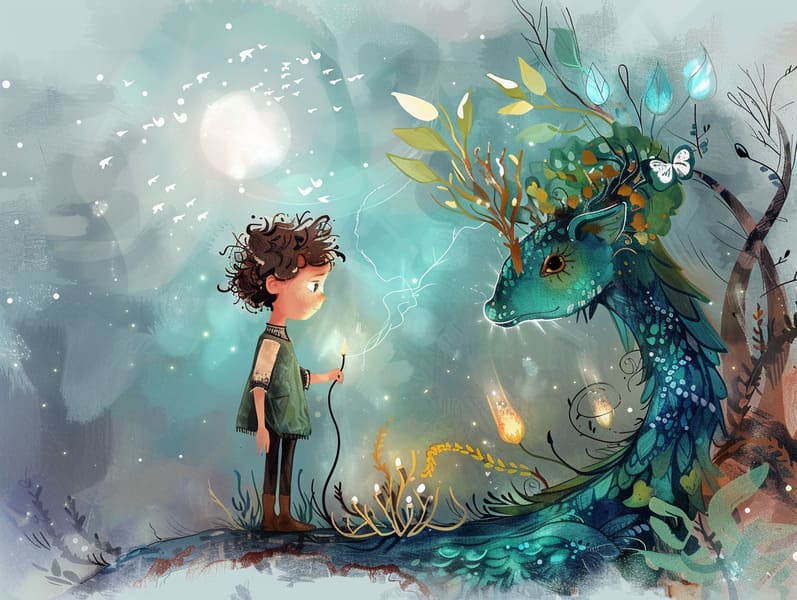
Old fairy tales have deep roots. These narratives have been whispered from one generation to the next millennia before they were ever documented. They sprang from a variety of traditions, including Middle Eastern traditions. They were initially disseminated among adults, often carrying themes and messages aligned with the societal norms and beliefs of the time.
Jacob and Wilhelm Grimm, Jacob and Wilhelm, were among the first to assemble many of these beloved fairy tales. Their published works, "Grimm's Folk Tales," included stories like "The Story of Cinderella," "The Story of Hansel and Gretel," and "Snow-White and Rose-Red," which have since become cornerstones in the world of timeless fairy tales. Similarly, Hans Andersen's delightful tales, such as "The Sea Maid," and "The Story of the Ugly Duckling," have touched hearts worldwide, securing their place in the pantheon of classic fairy tales.
Despite their ancient origins, fairy tales remain as significant as ever, especially as kids' bedtime tales. These enchanting tales are now available in multiple formats, including gorgeously illustrated books, magical animations, and digital fairy tales.
Their enduring popularity can be credited to several captivating elements:
Crucial Morals: Ancient fairy tales often share important moral lessons. Stories like "The Tale of the Boy Who Cried Wolf" teach the virtue of integrity, while "The Tortoise and the Hare" exemplify the virtues of persistence and humbleness. These tales offer the young clear distinctions between correct and incorrect, helping to shape their moral compass in a mild yet important way.
Empathy and Understanding: Old fairy tales frequently involve figures facing problems and hurdles, fostering audiences to understand with their struggles and encourage their triumphs. For instance, "The Tale of Beauty and the Beast" shows us the merit of seeing inner beauty to appreciate the inner spirit of a individual, promoting warmth and knowledge.
Cultural Perception: Many ancient fairy tales are rooted in the cultural contexts from which they emerged. Exploring these stories can provide enlightening views into different ways of life, developing a sense of world appreciation and comprehension.
Imagination and Creativity: The imaginative elements in ancient fairy tales—spells and potions—invigorate children’s creative dreams. These fairy tales transport readers to supernatural realms, engendering creative thinking and a sense of awe that stays a lifetime.
Ancient fairy tales are not only magical but also enlightening. They work as charming tools in cultivating various mental and emotional abilities in young readers. When classic fairy tales are told out loud, they advance verbal skills by presenting new words and complex sentence structures. This practice also strengthens listening skills and concentration, as little ones keep up with the story, enthusiastic to see what happens next.
Furthermore, exploring the themes and characters of traditional fairy tales can develop critical thinking and cognitive skills. Young readers are guided to recognize patterns, foresee events, and get cause and effect. These debates also benefit children voice their thoughts and feelings, cultivating their emotional intelligence.
In today’s technological age, the prevalence of free fairy tales online has made these fairy tales more reachable than ever. Online platforms and programs offer ample collections of traditional fairy tales that can be experienced or heard anytime, anywhere. Fairy tales narrated are particularly common, supplying an fun way for young ones to take part in these bewitching tales. Read-aloud books and read-out-loud stories move characters and settings to life, often augmented by delightful harmonies and music that augment the story adventure.
The timeless appeal of old fairy tales lies in their ability to transform to changing times while staying true to their core messages. Contemporary reinterpretations of these fairy tales often introduce more representative characters and modern settings, making them accessible to today’s audience. However, the fundamental themes of fearlessness, benevolence, and integrity remain unchanged, continuing to resonate with young readers of all ages.
Timeless fairy tales also offer a sense of coziness and homeliness. They yield a ordered narrative with a clear beginning, middle, and end, often concluding with the culmination of conflicts and the triumph of virtue over corruption. This reliability can be heartening for kids, affording a sense of consistency in an unstable world.
Ancient fairy tales continue to spellbind and coach new generations, maintaining their grace and meaningfulness in modern society. As children's bedtime stories, they furnish a perfect blend of fantasy and learning, fostering moral values, empathy, and creativity. The proliferation of web-based fairy tales and the sought after status of fairy tales told out loud secure that these ancient stories remain accessible to new generations.
By protecting and relating these fairy tales, we continue to value the check it out rich tapestry of lore and cultural heritage. Whether you are exploring a colorful picture book, exploring a internet library, or listening to an voice book, the splendor of ancient fairy tales is always within reach. These tales reveal of the everlasting power of narratives and its ability to unify us across time and space.
Be it you are browsing a vividly illustrated book, browsing a electronic collection, or listening via an audiobook, the splendor of timeless fairy tales is always within reach.
These fairy tales show us of the unwavering force of tales and its ability to connect us across generations and cultures, establishing a link that charms and informs alike.